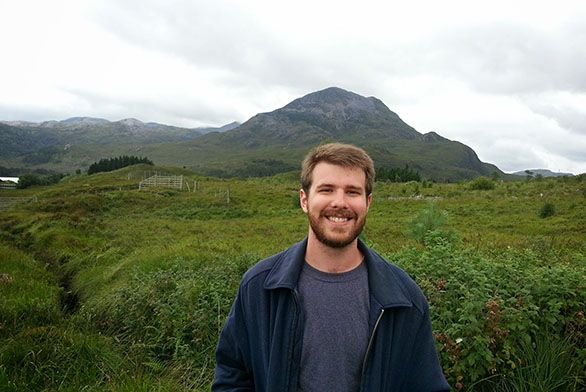Surveying the Sky
July 25, 2018 | By Eve Tolpa

Growing up in Moriarty, New Mexico, where dark skies provide the backdrop for an expanse of brilliant stars, Michael Fausnaugh (SF11) developed an interest in astronomy that would last a lifetime—and eventually land him a career at one of the most prestigious institutions in the world.
Since May 2017, Fausnaugh has been working at MIT’s Kavli Institute, where he serves as a pipeline/research scientist for NASA’s Transiting Exoplanet Survey Satellite (TESS). The satellite, which surveys the night sky for small planets orbiting bright stars, is on a two-year mission exploring both the northern and southern skies.
As a research scientist, Fausnaugh’s role is twofold. First, he analyzes the satellite images created by TESS every half hour and converts the data into lab results. This part of the job, he says, involves “lots of algorithms and software development and sanity-checking and verification.”
His second duty sounds even more glamorous: helping with the selection of stars. In the last five to seven years, Fausnaugh says, astronomers have concluded that “there are just planets all over the place" and that "on average, almost every star has a planet.” Since computational resources are not available to analyze every star for attendant planets, 200,000 stars need to be carefully targeted—and it’s up to him and his team to decide which.
According to Fausnaugh, TESS’s data can be used for numerous purposes, including detailed atmospheric study and the determination of the discovered planets’ surface makeup.
“Eventually," he says, "we might be able to determine if the planets can support life or if they have bio-signatures, but that work will be done by other telescopes.”
Though his interests seem technical, Fausnaugh has always seen science as operating hand-in-hand with the liberal arts. Fittingly, by the time he was a senior in high school, St. John’s was the only college on his list.
"The more science you do, the more you get interested in philosophy," he says.“I always wanted to look at physics in a fundamental way, and the different philosophical implications for it. Things start out easy enough; it’s just force laws and pushing things around. Things get pretty weird when you have to start talking about atoms and quantum mechanics. So those are the kind of questions that really grabbed me and got me more interested in philosophy.”
In his junior year at St. John’s, Fausnaugh worked as an assistant in the college labs, and he was also head lab assistant for senior lab. The summer after he graduated, he participated in an Ariel Internship at the Adler Planetarium in Chicago.
He went on to earn his PhD from the Ohio State University’s astronomy department, where students met every morning to discuss new astrophysics papers that had been released overnight.
This community-oriented aspect of the program, which he calls “very seminar-like,” appealed to him: “It’s very collaborative. People have their doors open and are excited to work with each other, which was not true of every department I visited.”
Now, as a working scientist, he is even more appreciative of his St. John’s education.
“St. John’s has a really excellent history of math and science program. I’d probably say it’s the best in the world,” he says. “When I left, I didn’t appreciate the difference between the practice of science and active research, compared to the history of math and science.”
And while the latter is not always necessary in addressing the everyday details of a project, he says, “having an intuition for what these fundamental reasons that we sign on to something like special relativity [are] or what we think conservation of energy is—that can be enormously helpful in trying to work through a puzzle.”
While Fausnaugh observes that people working in scientific fields can sometimes get bogged down by details, the liberals arts, and St. John’s in particular, provide the opportunity to step back and take a wider view.
“The people that are running projects are certainly thinking about these things,” he says, “but it’s important in the day-to-day work to remember what you’re doing.”

